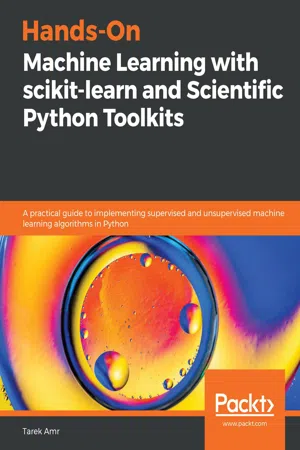
Hands-On Machine Learning with scikit-learn and Scientific Python Toolkits
A practical guide to implementing supervised and unsupervised machine learning algorithms in Python
- 384 pages
- English
- ePUB (mobile friendly)
- Available on iOS & Android
Hands-On Machine Learning with scikit-learn and Scientific Python Toolkits
A practical guide to implementing supervised and unsupervised machine learning algorithms in Python
About this book
Integrate scikit-learn with various tools such as NumPy, pandas, imbalanced-learn, and scikit-surprise and use it to solve real-world machine learning problems
Key Features
- Delve into machine learning with this comprehensive guide to scikit-learn and scientific Python
- Master the art of data-driven problem-solving with hands-on examples
- Foster your theoretical and practical knowledge of supervised and unsupervised machine learning algorithms
Book Description
Machine learning is applied everywhere, from business to research and academia, while scikit-learn is a versatile library that is popular among machine learning practitioners. This book serves as a practical guide for anyone looking to provide hands-on machine learning solutions with scikit-learn and Python toolkits.
The book begins with an explanation of machine learning concepts and fundamentals, and strikes a balance between theoretical concepts and their applications. Each chapter covers a different set of algorithms, and shows you how to use them to solve real-life problems. You'll also learn about various key supervised and unsupervised machine learning algorithms using practical examples. Whether it is an instance-based learning algorithm, Bayesian estimation, a deep neural network, a tree-based ensemble, or a recommendation system, you'll gain a thorough understanding of its theory and learn when to apply it. As you advance, you'll learn how to deal with unlabeled data and when to use different clustering and anomaly detection algorithms.
By the end of this machine learning book, you'll have learned how to take a data-driven approach to provide end-to-end machine learning solutions. You'll also have discovered how to formulate the problem at hand, prepare required data, and evaluate and deploy models in production.
What you will learn
- Understand when to use supervised, unsupervised, or reinforcement learning algorithms
- Find out how to collect and prepare your data for machine learning tasks
- Tackle imbalanced data and optimize your algorithm for a bias or variance tradeoff
- Apply supervised and unsupervised algorithms to overcome various machine learning challenges
- Employ best practices for tuning your algorithm's hyper parameters
- Discover how to use neural networks for classification and regression
- Build, evaluate, and deploy your machine learning solutions to production
Who this book is for
This book is for data scientists, machine learning practitioners, and anyone who wants to learn how machine learning algorithms work and to build different machine learning models using the Python ecosystem. The book will help you take your knowledge of machine learning to the next level by grasping its ins and outs and tailoring it to your needs. Working knowledge of Python and a basic understanding of underlying mathematical and statistical concepts is required.
Frequently asked questions
- Essential is ideal for learners and professionals who enjoy exploring a wide range of subjects. Access the Essential Library with 800,000+ trusted titles and best-sellers across business, personal growth, and the humanities. Includes unlimited reading time and Standard Read Aloud voice.
- Complete: Perfect for advanced learners and researchers needing full, unrestricted access. Unlock 1.4M+ books across hundreds of subjects, including academic and specialized titles. The Complete Plan also includes advanced features like Premium Read Aloud and Research Assistant.
Please note we cannot support devices running on iOS 13 and Android 7 or earlier. Learn more about using the app.
Information
- Chapter 1, Introduction to Machine Learning
- Chapter 2, Making Decisions with Trees
- Chapter 3, Making Decisions with Linear Equations
- Chapter 4, Preparing Your Data
- Chapter 5, Image Processing with Nearest Neighbors
- Chapter 6, Classifying Text Using Naive Bayes
- Understanding machine learning
- The model development life cycle
- Introduction to scikit-learn
- Installing the packages you need
Understanding machine learning
Types of machine learning algorithms

Supervised learning
Classification versus regression
Supervised learning evaluation
- Classifier evaluation metrics: Suppose we are using a classifier to determine whether a traveler is going to return. Then, of those travelers that the classifier predicted to return, we want to measure what percentage of them actually did return. We call this measure precision. Also, of all travelers who did return, we want to measure what percentage of them the classifier correctly predicted to return. We call this recall. Precision and recall can be calculated for each class—that is, we can also calculate precision and recall for the travelers who did not return.
Table of contents
- Title Page
- Copyright and Credits
- About Packt
- Contributors
- Preface
- Section 1: Supervised Learning
- Introduction to Machine Learning
- Making Decisions with Trees
- Making Decisions with Linear Equations
- Preparing Your Data
- Image Processing with Nearest Neighbors
- Classifying Text Using Naive Bayes
- Section 2: Advanced Supervised Learning
- Neural Networks – Here Comes Deep Learning
- Ensembles – When One Model Is Not Enough
- The Y is as Important as the X
- Imbalanced Learning – Not Even 1% Win the Lottery
- Section 3: Unsupervised Learning and More
- Clustering – Making Sense of Unlabeled Data
- Anomaly Detection – Finding Outliers in Data
- Recommender System – Getting to Know Their Taste
- Other Books You May Enjoy